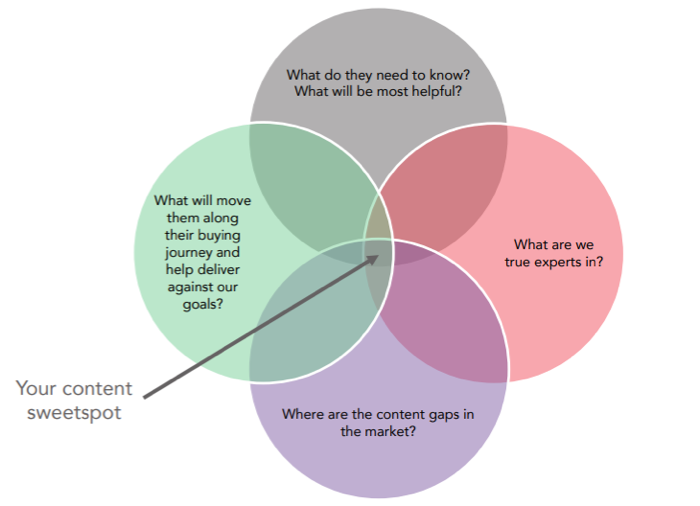
As a life science marketing pro, you’re likely to be one of those people who love to share their industry expertise and experiences by attending networking sessions and events. Earlier this year, one of our directors, Paul, was lucky enough to be invited to speak at the Cambridge HubSpot User Group meet-up—a quarterly event for local HubSpot users to exchange ideas, discuss trends and challenges, and learn from each other’s experiences. With the recent content marketing explosion, the last HUG event was focussed on a key industry challenge: how to make your content stand out from the noise.
As a marketer that may specialise in content creation and inbound marketing, this is a challenge you are likely to have faced before. So, what’s the solution? Here are some insights from Paul’s talk at the recent HUG event.
Skip ahead:
Lesson 1: Develop bulletproof buyer personas
Lesson 2: Create content that speaks to your buyer personas
Lesson 3: Master the art of content scaling
Why life science marketers need to go vertical
Do you find yourself endlessly scrolling through content on your social media feed? Is your inbox bursting with daily emails promoting eBooks, white papers, webinars, and blog posts? The recent content explosion means there is a lot of background noise, making it harder than ever for your content to stand out and get noticed—and the situation is only getting worse. So, how do you get your buyer personas to tune into your unique message and engage with your content? The answer: by going vertical.
To cut through the noise, you need to better align your inbound marketing efforts against the needs of each of your vertical market segments, and ensure the content you produce is relevant to their specific interests/needs. That way, you’ll be sure to speak directly to your prospects’ goals, pain points and challenges, making your content more attractive and helping it stand out from the ‘content crowd’. But how do you achieve this?
Lesson 1: Develop bulletproof buyer personas
Despite often being overlooked, buyer personas are the keystone of any inbound marketing strategy, and are designed to help life science marketers put the customer at the centre of their campaigns. This ensures your customers’ needs, goals, and challenges are at the very centre of all your communications, helping your content resonate better with them. We’ve blogged before about what every marketer should know when developing buyer personas, but here are our top tips for creating bulletproof personas that can drive your inbound content strategy:
- Use a template: Using a template for your buyer personas will ensure the creation process is consistent and repeatable, as you’ll most likely be developing multiple personas. You can download a template that we’ve honed and adapted over time in our free eBook ‘How to develop an awesome life science marketing plan’.
- Gather customer insight: To create the most accurate buyer personas, you should ideally look to gather customer information by conducting external research, interviews and surveys. However, with time and resource often being a limiting factor, you should at least look to brainstorm each persona with a diverse internal team e.g., marketing, customer support, sales and product development etc., to collect the best insight.
- Not too many, not too few: When deciding how many buyer personas to create, you need to aim for the ‘goldilocks’ zone—not too many, not too few, but just the right amount. This ultimately depends on your company, but it’s important to figure out how much you can divide your market segments up without getting too granular (and ending up with 100 different buyer personas to develop). If you find yourself repeating the same information in each persona, consider consolidating some together as this will be more valuable in the long run for content creation.
- Adapt and optimise: The scientists within us love to test, analyse and adapt based on our findings—and this principle should be upheld when developing your buyer personas. The personas should be considered as working documents and therefore should be regularly reviewed, updated, and refined as needed.
Lesson 2: Create content that speaks to your buyer personas
With up-to-date and complete buyer personas in hand, the next step is to use them to drive the tactical implementation of your inbound marketing programme, and create content that is so compelling your prospects simply wouldn’t be doing their job properly if they didn’t read, watch, or download it. We’ve previously shared five ways to make your life science content more persuasive, but here are some of our top tips for creating compelling content that resonates with your buyer personas:
- Use key customer information: When collecting information from your buyer personas, use they key customer questions, challenges, and objectives you collected to influence your content topics. After all, you know that these are the things your prospects really care about.
- Answer your prospects’ questions and show you understand their challenges: Take a leaf out of Marcus Sheridan’s book, “They ask you answer”—If you want your prospects to use your website and marketing materials to convince themselves to buy your products, answer as many of their questions and objectives upfront as possible.
- Create unique content: Before deciding on the topic or specific focus of a piece of content, it’s always worth researching what content offers already exist on the subject. If there are 10 eBooks on the same topic, find a unique angle or different way of presenting the information to differentiate your materials from the crowd.
- Find your content ‘sweet spot': Rank your content ideas for each market segment against the four questions below, to see which best hit what we call the 'content sweet spot’. This will make sure the content you invest time and resources creating will stand out, grab attention, and deliver unique value. This approach tends to work best when brainstorming content at the awareness stage of the buyer’s journey and when coming up with ideas to position your company as a thought leader in the industry.

- Map your content ideas against the buyer’s journey: Finally, map each of your content ideas against the buyer’s journey to make sure you are covering each stage (awareness, consideration and decision) and will have sufficient content to nurture people through until they ultimately become customers.
Lesson 3: Master the art of content scaling
You’re probably thinking that targeting each of the different stages of the buyer’s journey for all of your vertical segments means creating a lot of content—and you’re most likely wondering how on earth you are meant to achieve this! But by being careful and considered with how you scale content across different verticals, you’ll be relieved to hear that you won’t have to produce as much content as you might think.
- Identify common themes in your buyer personas: When creating a high-value piece of content like an eBook, look for common themes across your different buyer personas, such as challenges and goals they share. While ~80% of the eBook’s content will be the same for each market segment, you can easily tailor the other 20% to each audience, effectively creating a series of eBooks from a single ‘keystone’ piece of content, all with minimal work.
- Plan your content so it can be easily scaled: By carefully considering the topics you want to cover, the format, and structure, the same piece of content can effectively be used to target different market segments. For example, by designing a survey with questions that segment your audience, you can easily compile a full report and an additional 4-5 micro-reports targeted to these different buyer personas—all from the same survey!
- Repurpose, reuse, recycle: ‘Repurpose’ is one of our favourite terms, and the concept of reusing content you have already spent time and resources creating is an extremely efficient method of content generation. The best place to start is to conduct a content audit to see what you already have to play with—and if you’re producing a new content plan, always think ahead for how you can repurpose materials later on.
Overcome the life science content explosion
As an inbound marketer working in the life science sector, it is harder than ever to get your content to cut through the noise. People are inundated with a high volume of content that makes it easy for great pieces to be overlooked. However, by taking a vertical approach to your inbound marketing strategy that is centred around effective buyer personas, you can create content that directly speaks to your prospects’ challenges, pain points and goals. By creating compelling content that is solely focussed on what your customers actually care about (rather than what you think they care about) and thinking of clever ways to scale this across different market segments, you’ll find you will ultimately generate more leads and sales.
If you’d like help developing bulletproof buyer personas or engaging content targeted to your vertical markets, why not get in touch with our specialist inbound marketing team today?





